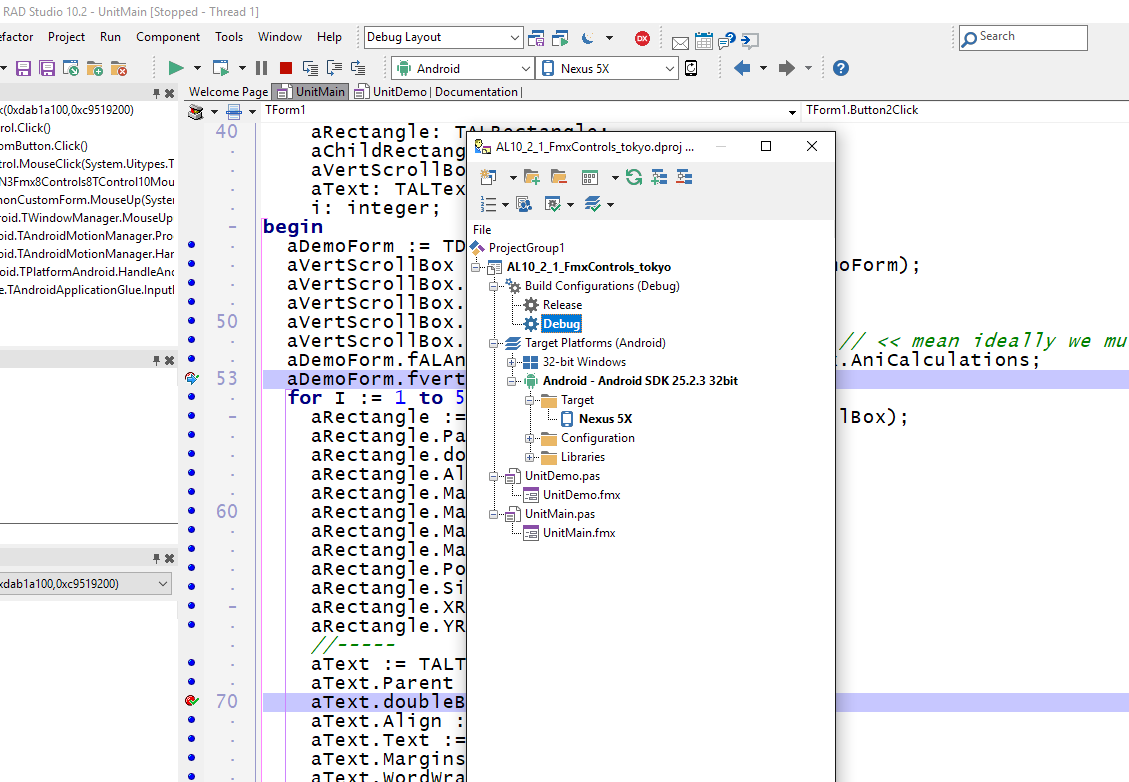In RAD Studio 10.2.1 we added support for debug visualizers for Delphi generic and C++ template types. A debug visualizer is an IDE plugin that allows you to change the display of a variable in the various debug windows, such as Local Variables and Watches.
"Great!", you may think, "but how do I actually write one of these visualizers?"
Pretty easily, as it turns out.
A debug vizualiser is an interfaced class that implements some specific Open Tools API interfaces (see toolsapi.pas), located in a DLL or package, and an instance of which is registered with the IDE when the package is loaded. Those interfaces are:
- IOTADebuggerVisualizer, IOTADebuggerVisualizer250: name and description of the visualizer, list of types it's interested in; version 250 adds support for generics or templates by allowing you to specify that a type string is for a generic or template type.
- IOTADebuggerVisualizerValueReplacer: this lets you replace the result of an expression returned by the debug evaluator with some other content - whatever you want. You can get more advanced than this, such as showing an external window for the results. This is just a simple example.
- IOTAThreadNotifier, IOTAThreadNotifier160: let you handle an evaluation completing. A notifier, by convention in the ToolsAPI, also always has four other methods to do with saving, destroying and modification that are not meaningful in this example.
Generic and template debug visualizer example
Here's a complete visualizer code snippet. To test this out, create a new package, and add designide to the Requires. Then add a unit called GenericVisualizer.pas to it and paste in the following source code. To test it out, just right-click and Install, and then it's running right there inside your local IDE instance. (You can also debug the IDE with IDE if you want to do some more advanced work and load it while debugging an instance of the IDE with your first copy of the IDE.)
Source code
.
unit GenericVisualizer;
interface
procedure Register;
implementation
uses
Classes, SysUtils, ToolsAPI;
type
TGenericVisualizer = class(TInterfacedObject, IOTADebuggerVisualizer,
IOTADebuggerVisualizer250, IOTADebuggerVisualizerValueReplacer,
IOTAThreadNotifier, IOTAThreadNotifier160)
private
FCompleted: Boolean;
FDeferredResult: string;
public
{ IOTADebuggerVisualizer }
function GetSupportedTypeCount: Integer;
procedure GetSupportedType(Index: Integer; var TypeName: string;
var AllDescendants: Boolean); overload;
function GetVisualizerIdentifier: string;
function GetVisualizerName: string;
function GetVisualizerDescription: string;
{ IOTADebuggerVisualizer250 }
procedure GetSupportedType(Index: Integer; var TypeName: string;
var AllDescendants: Boolean; var IsGeneric: Boolean); overload;
{ IOTADebuggerVisualizerValueReplacer }
function GetReplacementValue(const Expression, TypeName,
EvalResult: string): string;
{ IOTAThreadNotifier }
procedure EvaluateComplete(const ExprStr: string; const ResultStr: string;
CanModify: Boolean; ResultAddress: Cardinal; ResultSize: Cardinal;
ReturnCode: Integer);
procedure ModifyComplete(const ExprStr: string; const ResultStr: string;
ReturnCode: Integer);
procedure ThreadNotify(Reason: TOTANotifyReason);
procedure AfterSave;
procedure BeforeSave;
procedure Destroyed;
procedure Modified;
{ IOTAThreadNotifier160 }
procedure EvaluateComplete(const ExprStr: string; const ResultStr: string;
CanModify: Boolean; ResultAddress: TOTAAddress; ResultSize: LongWord;
ReturnCode: Integer);
end;
type
TGenericVisualierType = record
TypeName: string;
IsGeneric: Boolean;
end;
const
GenericVisualizerTypes: array [0 .. 4] of TGenericVisualierType = (
(TypeName: 'MyGenericType.IGenericInterface<T,T2>'; IsGeneric: True),
(TypeName: 'MyGenericType.TGenericClass<System.Integer>'; IsGeneric: False),
(TypeName: 'MyGenericType.TGenericClass<T>'; IsGeneric: True),
(TypeName: 'std::vector<T, Allocator>'; IsGeneric: True),
(TypeName: 'std::map<K, V, Compare, Allocator>'; IsGeneric: True)
);
{ TGenericVisualizer }
procedure TGenericVisualizer.AfterSave;
begin
// don't care about this notification
end;
procedure TGenericVisualizer.BeforeSave;
begin
// don't care about this notification
end;
procedure TGenericVisualizer.Destroyed;
begin
// don't care about this notification
end;
procedure TGenericVisualizer.Modified;
begin
// don't care about this notification
end;
procedure TGenericVisualizer.ModifyComplete(const ExprStr, ResultStr: string;
ReturnCode: Integer);
begin
// don't care about this notification
end;
procedure TGenericVisualizer.EvaluateComplete(const ExprStr, ResultStr: string;
CanModify: Boolean; ResultAddress, ResultSize: Cardinal; ReturnCode: Integer);
begin
EvaluateComplete(ExprStr, ResultStr, CanModify, TOTAAddress(ResultAddress),
LongWord(ResultSize), ReturnCode);
end;
procedure TGenericVisualizer.EvaluateComplete(const ExprStr, ResultStr: string;
CanModify: Boolean; ResultAddress: TOTAAddress; ResultSize: LongWord;
ReturnCode: Integer);
begin
FCompleted := True;
if ReturnCode = 0 then
FDeferredResult := ResultStr;
end;
procedure TGenericVisualizer.ThreadNotify(Reason: TOTANotifyReason);
begin
// don't care about this notification
end;
function TGenericVisualizer.GetReplacementValue(const Expression, TypeName,
EvalResult: string): string;
begin
Result := 'Generic visualizer:' + '; ' +
'Expression: ' + Expression + '; ' +
'Type name: ' + TypeName + '; ' +
'Evaluation: ' + EvalResult;
end;
function TGenericVisualizer.GetSupportedTypeCount: Integer;
begin
Result := Length(GenericVisualizerTypes);
end;
procedure TGenericVisualizer.GetSupportedType(Index: Integer;
var TypeName: string; var AllDescendants: Boolean);
begin
AllDescendants := True;
TypeName := GenericVisualizerTypes[index].TypeName;
end;
procedure TGenericVisualizer.GetSupportedType(Index: Integer;
var TypeName: string; var AllDescendants: Boolean; var IsGeneric: Boolean);
begin
AllDescendants := True;
TypeName := GenericVisualizerTypes[index].TypeName;
IsGeneric := GenericVisualizerTypes[index].IsGeneric;
end;
function TGenericVisualizer.GetVisualizerDescription: string;
begin
Result := 'Sample on how to register a generic visualizer';
end;
function TGenericVisualizer.GetVisualizerIdentifier: string;
begin
Result := ClassName;
end;
function TGenericVisualizer.GetVisualizerName: string;
begin
Result := 'Sample Generic Visualizer';
end;
var
GenericVis: IOTADebuggerVisualizer;
procedure Register;
begin
GenericVis := TGenericVisualizer.Create;
(BorlandIDEServices as IOTADebuggerServices).RegisterDebugVisualizer(GenericVis);
end;
procedure RemoveVisualizer;
var
DebuggerServices: IOTADebuggerServices;
begin
if Supports(BorlandIDEServices, IOTADebuggerServices, DebuggerServices) then
begin
DebuggerServices.UnregisterDebugVisualizer(GenericVis);
GenericVis := nil;
end;
end;
initialization
finalization
RemoveVisualizer;
end.
To test
For Delphi
Define some types:
.
type
IGenericInterface<T,T2> = interface
['{2395EEA7-7E2E-485E-B6D3-C424A12FAE7F}']
end;
TGenericClassFromInterface<T,T2> = class(TInterfacedObject, IGenericInterface<T,T2>)
end;
TGenericClass<T> = class(TObject)
end;
TGenericClassDescendant<T> = class(TGenericClass<T>)
end;
TGenericClassDescendantInt = class(TGenericClass<Integer>)
end;
This example is longer than the C++ one, because it demonstrates both generic classes and interfaces. It also shows some descendant types, where you need to register the descendant type separately. (For a non-generic-type debug visualizer, the visualizer is called for descendants of the registered type automatically.)
And create a new console app, giving it the contents:
.
procedure foo;
var
a: TGenericClassFromInterface<Integer, string>;
a1: IGenericInterface<Integer, string>;
b: TGenericClass<string>;
c: TGenericClass<Integer>;
d: TGenericClassDescendant<string>;
e: TGenericClassDescendantInt;
begin
a := TGenericClassFromInterface<Integer, string>.Create;
a1 := a;
b := TGenericClass<string>.Create;
c := TGenericClass<Integer>.Create;
d := TGenericClassDescendant<string>.Create;
e := TGenericClassDescendantInt.Create;
writeln('abc'); // set breakpoint here
end;
begin
try
foo;
except
on E: Exception do
Writeln(E.ClassName, ': ', E.Message);
end;
end.
For C++
Create a new console app (and some shiny new template types as well, if you wish) and give it the contents:
.
int _tmain(int argc, _TCHAR* argv[])
{
std::vector<int> myVec;
std::map<int, std::string> myMap;
return 0; // BP here
}
To extend
This is the exciting bit! Try changing the data returned from GetReplacementValue(), and also try evaluating expressions yourself in the visualizer to use in the returned replacement.
Have fun!




































